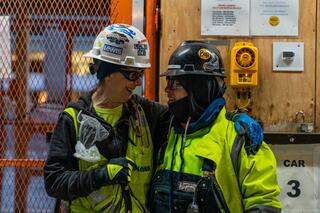Building the Future for Women in Construction
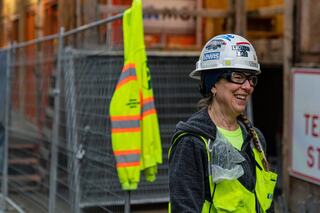
We shadowed Journeyman Operator Mercedes Toro and Journeyman Laborer Karen Francis to learn what it’s like to work at Rainier Square, how they found a career in construction and what they are doing to change the future of the industry. The two have more in common than meets the eye.
We shadowed Journeyman Operator Mercedes Toro and Journeyman Laborer Karen Francis to learn what it’s like to work at Rainier Square, how they found a career in construction and what they are doing to change the future of the industry. The two have more in common than meets the eye.

On the corner of 4th and Union in the heart of downtown Seattle, construction has hummed overhead for months as Lease Crutcher Lewis builds Seattle’s second tallest building, Rainier Square. By now, the building is fully enclosed, but inside the building is still busy; workers are scattered throughout the site trying to bring this tower closer to completion with every scope they turn over. Just outside the site fencing, things are just as active as hundreds of commuters and buses zoom past the tower on 4th avenue, only feet from the edge of the jobsite.
One of the most familiar faces onsite—and to the public who pass by on 4th avenue—belongs to Karen Francis, a Journeyman Laborer. After flagging at Rainier for nearly two years, she’s fearless and well known by Seattle’s metro bus drivers. Often, they give her a wave and a smile as they drive past her on each route.
She’s spent more than three decades working in construction and has seen just about everything. Her warm smile, radiant voice and signature long braid make her recognizable under her well-worn hardhat and work gear. She’s most known as the site flagger; the hub of logistics at street level, and she never stops moving. When massive trucks arrive to deliver materials she springs into action, perfectly choreographing trucks and street traffic so crews get what they need quickly and safely.
Just above her, climbing the side of the 58-story tower in a personnel lift, the also-familiar face of Journeyman Operator Mercedes Toro greets workers on each floor. From dawn to dusk Mercedes moves people and equipment up and down the building. Much like Karen, she gets people and equipment where they need to be, and fast, because to Mercedes, downtime is a waste. The workers on site call her “Captain Hook” because she uses a large claw-like hook to open and close the lift door.
The two have a striking similarity—the same laugh, the same long braids and the same infectious personalities. It makes sense because Mercedes is Karen’s daughter.
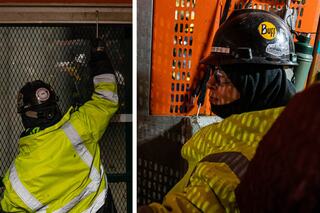
Finding Construction
As a young child, Mercedes remembers how ingrained construction was in her life. She recalls watching her mom lace up her work boots and pour a mug of hot coffee before she took her two young kids to a babysitter and headed to the jobsite—all before dawn. Until recently, women like Karen were rare on jobsites, but the trades are changing, and every day more and more women find their places on construction teams.
Karen joined the construction industry in 1984. As she was moving her two young kids to a new home, she was interrupted by a construction crew paving the street in front of her house, including a woman on the crew. “I don’t know who she was…she was way before her time, but this woman went by on an [asphalt] roller and I thought, ‘well, I can do that!’” Karen said, “I called every union in the phonebook until the laborers took me.”
Mercedes’ first experience on a jobsite was as a young child. She remembers how loud the machinery was, and how her mom was the only woman on her team. “[My brother and I] thought it was cool that she worked in construction,” Mercedes said, “She’d pick us up from school and she’d be so dirty. She was so different than my friends’ moms…I knew it was something I wanted to be when I grew up.”
Many think Mercedes followed her mom’s footsteps, and in many ways she did—as one of the very few female laborers in the industry—but at one point Mercedes saw a future for herself in ornamental horticulture. She quickly realized that construction was in her future and applied to every union she could.
“When I applied for the unions I said, ‘I was raised by a laborer and a roofer so I can handle anything,” Mercedes said with a laugh.
“She did it all on her own and I am really proud of her for that,” Karen said.
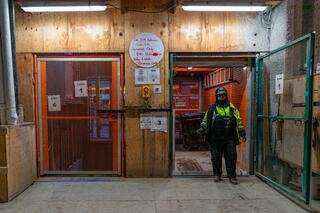
Close Connection
Since Mercedes started in the union, she and Karen have begun each workday the same way: a quick hug and the words “I love you. Have a good day. Be safe,” before they head into the jobsite.
“I’m just so happy to see [Mercedes] when I go to work. I get my hug and I am ready for the day.” Karen said. Even when they weren’t on the same job, they practiced the ritual on their 4 a.m. commutes.
“I see my mom working from the manlift. She always goes further than she needs to go. She can handle anything and never backs down. She’s so strong,” Mercedes said, “I feel like there’s something to be proud of by having her out there. She’s a real mentor to a lot of people onsite.”
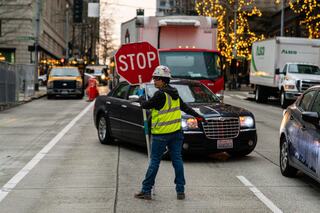
Paving the Way for the Future
In an industry that has historically lacked diversity in race and gender, we are seeing more and more women and people of color join the industry each year.
It’s common to hear of multi-generational families working in the trades or for a company. Stereotypically, young boys have seen their fathers and grandfathers as construction workers and followed suit with a similar dream. But what about young girls? When Karen joined the union in 1984, she was one of very few women onsite, but today, she has more female peers on the jobsite than ever—from carpenters, laborers and operators to other specialized trades. She is even led by a female foreman.
Without a female role model, Mercedes says she probably wouldn’t have started in this industry. “It only seemed like a possibility because my mom set the example,” she said.
Thankfully, more and more women are joining the industry, so children just like Mercedes can watch their moms pull on steel-toed work boots, grab their hard hats and head to the jobsite, knowing that their value in the construction industry is not based on gender.
Mercedes says the only way women can continue to succeed in the industry is if they are viewed equals. “Don’t cater to women, because it becomes a problem for both sides. Just accept us as your peers,” she said.
Karen’s words of wisdom have a similar ring, “you’re not a boy today, you’re not a girl today. You’re a laborer. You’re a carpenter. Go do your job as best you can and let go of the rest,” she said.
